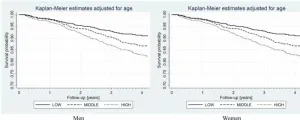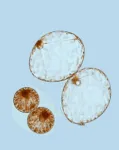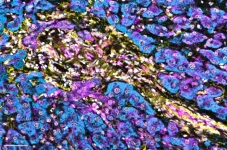(Press-News.org) When trying to understand how genetic influences factor into youth behavior, researchers at Washington University in St. Louis have taken the “big trawl” approach, casting their net wide to pull in all the measured traits, behaviors and environments that make up who we are and examine associations with the genetic building blocks comprising risk for mental health problems.
This cutting-edge methodology has turned up valuable new insights into factors related to psychopathological genetic risk, such as stressful life events and screen time. Although the results, published in Nature Mental Health, are unable to say if one causes the other, the findings provide promising leads to understand the nature of psychiatric disorders emerging during adolescence.
“We’re catching all the little fish here,” said Nicole Karcher, assistant professor of psychiatry at WashU Medicine, likening their genetic screening tools to trawling the ocean.
“But now we get to wade through the fish that we caught, and future steps include understanding the extent to which these are meaningful in terms of their ability to reduce risk for mental health concerns.”
An innovative approach to “catching” risk factors
Much of what we know about links between the genome and behavior come from Genome-wide Associations Studies (GWAS), which identify links between specific genetic variants across the genome and a feature of interest, also known as a phenotype. Phenotypes can range from physical characteristics to psychiatric disorders (e.g., depression, anxiety).
Many behavioral disorders are correlated at the genetic level. Results from a GWAS scanning for genetic links to depression, therefore, may also reflect genetic associations with frequently co-occurring conditions such as anxiety.
“We know that one behavioral variable is not going to be the only association with genetic risk, so we were interested in taking a more agnostic, data-driven approach to the wealth of information that is available in large datasets,” said Karcher.
Doing so would hopefully identify not only expected associations between genetic risk and psychiatric symptoms, but also potential novel associations that could improve insight into how psychiatric disorder risk may unfold.
So senior author Karcher and first author Sarah Paul, a graduate student in Ryan Bogdan's Behavioral Research and Imaging Neurogenetics Laboratory at Art & Sciences, ran what’s called a phenome-wide association study (PheWAS) that inverts the GWAS.
Rather than starting with the psychiatric condition and looking for associated genetic variants, their PheWAS started with genetic variants known to be linked with mental health disorders and examined their relationship to hundreds of measured variables reflecting behavior, symptoms, environments, health problems and other phenotypes. They included approximately 1,300 to 1,700 phenotypes in total from the Adolescent Brain Cognitive Development (ABCD) Study.
“We took a pretty broad approach,” said Paul, describing different phenotypes as “anything from impulse control problems and problematic behavior or psychotic-like experiences to screen time, to how much caffeine they consumed.”
Think of it as fishing with a big net.
That means they want to identify associations between genetic predisposition and potentially modifiable risk factors that can be potentially addressed before the onset of psychopathology, Bogdan, the Dean’s Distinguished Professor of Psychological & Brain Sciences in Arts & Sciences, said.
What they caught
The results of the PheWAS show some surprises and confirm some of what they already know about genetic risks and behaviors that are associated with mental health disorders in youth.
The WashU researchers took 11 GWAS and created four broad genetic risk factors, or polygenic scores: neurodevelopmental, internalizing (e.g., depression, anxiety), compulsive and psychotic. Below are some of the associations they found in those categories:
*Genetic risk for neurodevelopmental psychopathology (predominantly ADHD and Autism Spectrum Disorder, as well as Major Depressive Disorder and problematic alcohol use) was associated with some 190 phenotypes including inattention and impulsivity issues, as well as total screen time, sleep problems and psychotic-like experiences. Even environmental conditions like neighborhood crime rates and lower parental monitoring are associated with neurodevelopmental genetic risk.
*Genetic risk for internalizing behavior (Major Depressive Disorder, Generalized Anxiety Disorder, PTSD, as well as problematic alcohol use) were broadly associated with some 120 phenotypes such as depression, stressful life events, psychotic-like experiences and screen time.
*Psychotic risk (predominantly Schizophrenia and Bipolar Disorder) had few phenotype associations aside from lower school involvement and more consumption of energy drinks.
Karcher said it was somewhat surprising that “genetic liability” for mental health concerns may manifest through potentially modifiable behaviors in childhood and early adolescence.
The research sorted hundreds and hundreds of variables potentially associated with genetic risk, and the results highlighted several associations, including the association between neurodevelopmental genetic risk and screentime, she added.
“The PheWAS was able to point out these pockets of associations that may not have been found otherwise,” she said.
One such pocket was the association between psychotic disorder genetic risk and energy drink consumption. These studies are looking at correlation, not causation, so they cannot conclude that energy drink consumption causes psychotic disorders. It could be that there are genetic components that make these individuals more at risk for psychotic disorders and those same components might make these individuals more likely to consume caffeinated beverages.
A similar phenomenon could be a play with the strong association between screen time and neurodevelopmental risk.
The point of the PheWAS is not to sort those details of causation but get pointed in the right direction with “a 20,000-foot view of the associations,” Karcher said.
Time will tell as the ABCD kids get older and genomic databases get more diverse.
“Following these youth into early adulthood will help better inform how genetic risk is associated with things like screen time, psychopathology, symptoms, and sleep over the course of adolescence into early adulthood,” Paul said. “That will help paint a clearer picture of how these links between your overall genetic risk and your behavior and traits change or don’t change over time.”
Overall, the present work illustrates how the PheWAS technique can be used to identify potential targets for future prevention and early intervention strategies, with this study identifying several potentially modifiable targets, such as screen time and caffeinated beverage consumption, that could represent early “catches” for reducing risk for developing mental health concerns.
Previous genome-wide studies of psychiatric diagnoses/phenotypes make use of data from individuals most genetically similar to European reference populations, with limited well-powered GWAS available for other populations in the world. So, one major limitation of this study was that because the GWAS predominantly used data from European reference populations, only ABCD data from individuals with European ancestry could be used in the PheWAS.
“That really limits the generalizability of these findings,” Paul said, “but as more GWAS become available in individuals genetically similar to other reference populations, and as more sophisticated polygenic score approaches are developed, we should be able to expand the study population to be more inclusive.”
################
Paul SE, Colbert SMC, Gorelik AJ, Hansen IS, Nagella I, Blaydon L, Hornstein A, Johnson EC, Hatoum AS, Baranger DAA, Elsayed NM, Barch DM, Bogdan R, Karcher NR. Phenome-wide Investigation of Behavioral, Environmental, and Neural Associations with Cross-Disorder Genetic Liability in Youth of European Ancestry. Nat. Mental Health (2024). https://doi.org/10.1038/s44220-024-00313-2
Data for this study were provided by the Adolescent Brain Cognitive Development (ABCD) study , which was funded by awards U01DA041022, U01DA041025, U01DA041028, U01DA041048, U01DA041089, U01DA041093, U01DA041106, U01DA041117, U01DA041120, U01DA041134, U01DA041148, U01DA041156, U01DA041174, U24DA041123, and U24DA041147 from the NIH and additional federal partners (https://abcdstudy.org/federal-partners.html). This study was supported by R01 DA054750. Authors received funding support from NIH: SEP was supported by F31AA029934. NRK was supported by K23MH12179201. AJG was supported by NSF DGE-213989. ECJ was supported by K01DA051759. ASH was supported by K01AA030083. DMB (R01-MH113883; R01-MH066031; U01-MH109589; U01-A005020803; R01-MH090786), RB (R01-DA054750, R01-AG045231, R01-AG061162, R21-AA027827, R01-DA046224, U01-DA055367). NME was supported by NSF DGE-1745038.
END
WashU researchers use genetics to find psychopathology risks
A multitude of genetic, behavioral and environmental factors come together to create mental health problems in teens, study finds.
2024-10-17
ELSE PRESS RELEASES FROM THIS DATE:
Fibroblast growth factor 21 and survival in the elderly: Polsenior2 study results
2024-10-17
“Of note, participants with high serum levels of FGF21 more frequently had metabolic complications, such as hypertension, obesity, diabetes, hypercholesterolemia, and hypertriglyceridemia.”
BUFFALO, NY- October 17, 2024 – A new research paper was published in Aging (listed by MEDLINE/PubMed as "Aging (Albany NY)" and "Aging-US" by Web of Science), Volume 16, Issue 19 on September 18, 2024, entitled, “Fibroblast growth factor 21 inversely correlates with survival in elderly population – the results of the Polsenior2 study.”
As ...
Plankton balloon to six times their size in newly discovered mode of oceanic travel
2024-10-17
Many plankton journey from the cold, dark depths of our oceans to the surface, only to eventually drift down again into the darkness in a perpetual rhythm. Yet, how single-celled phytoplankton, most of which have no appendages to help them swim, make this pilgrimage has remained a mystery. In a paper publishing October 17 in the Cell Press journal Current Biology, researchers describe a species of bioluminescent phytoplankton, called Pyrocystis noctiluca, that balloons to six times their original size of a few hundred microns. This massive inflation allows the plankton to journey up to 200 meters toward the ocean’s surface to capture sunlight, then ...
Repurposing drugs to eliminate cellular origins of brain tumors
2024-10-17
Glioblastomas are aggressive brain tumors with a median survival time of less than 22 months despite standard therapy including surgery, irradiation, and chemotherapy. It has become clear in recent years that not all cells within the brain tumor have an equal potential to divide and drive tumor growth. As such, a fraction of tumor cells called brain tumor stem cells (BTSCs) are thought to be the primary origin of tumor re-growth after surgery in addition to being resistant to standard treatments including chemotherapy and irradiation. Therefore, targeting BTSCs may be a way to effectively treat glioblastomas.
In an effort to rapidly identify ...
Biomarker may predict immunotherapy response in liver cancer
2024-10-17
It may soon be possible to determine which patients with a type of liver cancer called hepatocellular carcinoma would benefit from immunotherapy, according to a preclinical study by Weill Cornell Medicine investigators.
The study, published Oct. 17 in Molecular Cell, provides new insights into a pair of proteins, called p62 and NBR1, and their opposing functions in regulating the interferon response in hepatic stellate cells, a critical immune component in the liver’s fight against tumors. The study demonstrates that high levels of the immune-suppressing NBR1 in these specialized cells may identify patients who are unlikely to respond ...
Prevalence of glaucoma among US adults in 2022
2024-10-17
About The Study: This meta-analysis found that an estimated 2.56% of people 40 years or older have glaucoma, slightly more than estimated by previous studies. Black individuals are disproportionately affected. Prevalence estimates at the state and county level can help guide public health planning.
Corresponding Author: To contact the corresponding author, Joshua R. Ehrlich, MD, MPH, email joshre@umich.edu.
To access the embargoed study: Visit our For The Media website at this link https://media.jamanetwork.com/
(doi:10.1001/jamaophthalmol.2024.3884)
Editor’s ...
Effect of electric fans on body core temperature in older adults exposed to extreme indoor heat
2024-10-17
About The Study: Electric fan use did not lower peak core temperature in older adults exposed to extreme indoor heat. Reductions in end-exposure core temperature and heart rate were observed, but they were small and of questionable clinical importance. Neither exceeded previous suggestions for clinical significance. Consistent with recent modeling, these data do not support fans as an efficacious standalone cooling intervention for older adults in hot indoor environments (>33-35 °C).
Corresponding Author: To contact the corresponding author, Glen P. Kenny, PhD, email gkenny@uottawa.ca.
To ...
Buprenorphine/naloxone vs methadone for the treatment of opioid use disorder
2024-10-17
About The Study: Individuals receiving methadone had a lower risk of treatment discontinuation compared with those who received buprenorphine/naloxone. The risk of mortality while receiving treatment was similar between medications.
Corresponding Author: To contact the corresponding author, Bohdan Nosyk, PhD, email bnosyk@sfu.ca.
To access the embargoed study: Visit our For The Media website at this link https://media.jamanetwork.com/
(doi:10.1001/jama.2024.16954)
Editor’s Note: Please see the article for additional information, including ...
Astrobiology: Potential microbial habitats in Martian ice
2024-10-17
Dusty ice exposed at the surface of Mars could provide the conditions necessary for the presence of photosynthetic life, according to a modelling study. The findings, published in Communications Earth & Environment, suggest that ice deposits located in the planet’s mid-latitudes should be a key location in any search for life on Mars.
High levels of harmful ultraviolet radiation from the Sun make current life on the surface of Mars almost certainly impossible. However, a sufficiently thick layer of ice can absorb this radiation and could protect cells living below its surface. Any life in these conditions ...
IChF tribute to the chemical imagination: the Dream Chemistry Award
2024-10-17
The Dream Chemistry Award (DCA) is a one-of-a-kind competition dedicated to recognizing young scientists who dream of tackling fundamental problems in chemistry and related disciplines with visionary ideas. Established in 2013 by the Institute of Physical Chemistry of the Polish Academy of Sciences (IChF), the award aims to support emerging talents in realizing their scientific dreams. Since 2017, it has been organized jointly with the Institute of Organic Chemistry and Biochemistry of the Czech Academy of Sciences (IOCB Prague), with the finals alternating between Prague and Warsaw.
The Dream Chemistry Award empowers those pursuing ...
New tool helps analyze pilot performance and mental workload in augmented reality
2024-10-17
In the high-stakes world of aviation, a pilot's ability to perform under stress can mean the difference between a safe flight and disaster. Comprehensive and precise training is crucial to equip pilots with the skills needed to handle these challenging situations.
Pilot trainers rely on augmented reality (AR) systems for teaching, by guiding pilots through various scenarios so they learn appropriate actions. But those systems work best when they are tailored to the mental states of the individual subject.
Enter HuBar, a novel visual analytics tool designed to summarize and compare task performance ...
LAST 30 PRESS RELEASES:
Injectable breast ‘implant’ offers alternative to traditional surgeries
Neuroscientists devise formulas to measure multilingualism
New prostate cancer trial seeks to reduce toxicity without sacrificing efficacy
Geometry shapes life
A CRISPR screen reveals many previously unrecognized genes required for brain development and a new neurodevelopmental disorder
Hot flush treatment has anti-breast cancer activity, study finds
Securing AI systems against growing cybersecurity threats
Longest observation of an active solar region
Why nail-biting, procrastination and other self-sabotaging behaviors are rooted in survival instincts
Regional variations in mechanical properties of porcine leptomeninges
Artificial empathy in therapy and healthcare: advancements in interpersonal interaction technologies
Why some brains switch gears more efficiently than others
UVA’s Jundong Li wins ICDM’S 2025 Tao Li Award for data mining, machine learning
UVA’s low-power, high-performance computer power player Mircea Stan earns National Academy of Inventors fellowship
Not playing by the rules: USU researcher explores filamentous algae dynamics in rivers
Do our body clocks influence our risk of dementia?
Anthropologists offer new evidence of bipedalism in long-debated fossil discovery
Safer receipt paper from wood
Dosage-sensitive genes suggest no whole-genome duplications in ancestral angiosperm
First ancient human herpesvirus genomes document their deep history with humans
Why Some Bacteria Survive Antibiotics and How to Stop Them - New study reveals that bacteria can survive antibiotic treatment through two fundamentally different “shutdown modes”
UCLA study links scar healing to dangerous placenta condition
CHANGE-seq-BE finds off-target changes in the genome from base editors
The Journal of Nuclear Medicine Ahead-of-Print Tip Sheet: January 2, 2026
Delayed or absent first dose of measles, mumps, and rubella vaccination
Trends in US preterm birth rates by household income and race and ethnicity
Study identifies potential biomarker linked to progression and brain inflammation in multiple sclerosis
Many mothers in Norway do not show up for postnatal check-ups
Researchers want to find out why quick clay is so unstable
Superradiant spins show teamwork at the quantum scale
[Press-News.org] WashU researchers use genetics to find psychopathology risksA multitude of genetic, behavioral and environmental factors come together to create mental health problems in teens, study finds.



